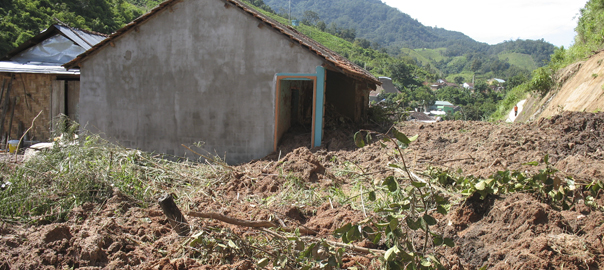In April, a cyclone devastated a small village along the coastline in northern Myanmar. Every family in the village – 65 families in all –suffered damage to their homes. Their roofs were gone. The school as well was damaged and the local church was completely destroyed.
Despite the hardship, the local church members sprang into action. They had learned about showing God’s love to their neighbors through the TCT program. They helped their neighbors by sharing what they had and working to rebuild homes.
The loving action of the local Christians astonished non-believers in the area and served to establish a good relationship with them. With the houses completed, the believers prayed that God would also provide for them to rebuild the church. The church started collecting donations from families and other area churches. Now, by the grace of God, the village is restored and the believers have already finished the church building’s foundation.
Recently John wrote about the differences between relief and development. In the TCT program we talk with our local trainers about how the church can respond to both kinds of needs. The church is called to respond compassionately when their neighbors are struggling, but the type of response differs by the situation. In addition to helping neighbors with long-term needs, the church can also be prepared to help in times of disaster.
In many areas where Reconciled World works, there are no aid agencies to provide relief when a disaster strikes. The church alone is there to respond. But in the U.S. the situation is different. Aid agencies with skilled professionals are ready when communities are in crisis. What role can a simple local church in the U.S. play when agencies like these are already involved?
I remember reading a story about a community in Honduras that suffered severe damage after a hurricane. Cut off from aid because of rising flood waters, the local church knew they were responsible to care for the community. The women organized to cook meals that the youth delivered to the elderly and the house-bound. Groups of men from the church worked to repair houses and collect donations. When a relief organization was finally able to arrive after two weeks, they were amazed at what the church had accomplished. The pastor’s response was priceless:
“We were here before the disaster, we were here during the disaster and we are here after the disaster. Agencies like yours will come and go, but the church will always be here.”[1]
The truth is that no group is better at caring for their neighbors than the local church. A disaster can result in a lot more than just physical need. Those affected also face emotional and spiritual needs as well. Who better to discern and meet these needs than a loving and committed local church?
4 Ways the Church can be ready to Respond in a Disaster
When a disaster strikes, the first 24 hours are critical. To respond effectively you need to be prepared. If your church takes a little bit of time to plan ahead, you can be ready to make a difference in a crisis. Here are four tips for getting started:
-
Think ahead about the types of disasters that are common in your area.
Whatever type of disasters are most common – whether floods, fires, tornadoes, hurricanes, blizzards – think about the particular needs that people face when these disasters strike. Pray that God would show you how your church could be a light in the midst of a crisis.
-
Plan ways that your church could respond to the needs.
What could your church do to help someone whose home has just burned down? What could you do for families who’ve lost power in a storm? What could you do to help travelers stranded by a blizzard? Whichever problems are common in your area, make a list of ways your church could practically help out. Don’t focus only on physical needs; think about the spiritual and emotional stress that a disaster can cause as well. How are children and the elderly uniquely affected? How could your church help families coping with a crisis?
-
Organize people and resources to be ready.
Think about the person or people in your church who could take responsibility for quickly organizing and helping. Knowing who is responsible and others who are willing to participate in advance will save time when a disaster hits. Also think about what materials or supplies you could keep on hand to provide in an emergency – donated clothes, food, toys for kids, or personal hygiene items.
-
Start getting to know your neighbors and community better through Acts of Love.
Don’t wait for a disaster to start showing God’s love. Start looking at the needs in your community now and plan ways your church could make a difference. Check out our TCT North America program for more ideas. The more involved your church is in community life, the better you’ll be able to know how to help in a crisis.
In Myanmar, when one church responded in love after a cyclone, it completely changed their relationship with non-believing neighbors. Imagine how people in your community might view the church differently if they saw you dedicated to caring for those in need after a disaster.
Have you seen ways that local churches in the U.S. have been able to respond in a disaster? We’d love to hear about it! Tell us in the comments below.
[1] Disasters and the Local Church, © Tearfund 2011



Leave A Comment